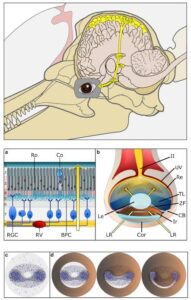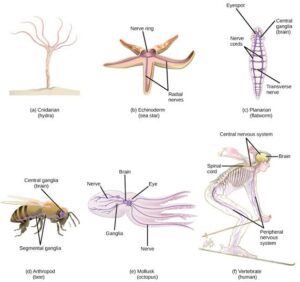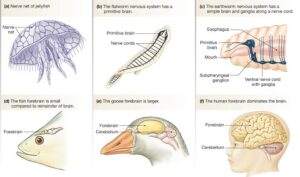Back to: ZOOLOGY 300 Level
Welcome To Class!
Hello there, champion! I’m truly proud of your commitment to learning. Today, we’ll be taking a closer look at the brain—yes, that amazing control centre in your head—and how it works in different animals. We’ll also see how their senses (like sight, hearing, and smell) have adapted to help them survive and thrive in their unique environments. Let’s get into it!
Brain Structures And Sensory Adaptation
Overview of Brain Structures in Vertebrates
The brain is a highly organised organ made up of several specialised regions. While the overall structure is similar across vertebrates, some parts are more developed in certain animals depending on their behaviour and environment.

- Forebrain (Cerebrum and Olfactory Lobes): This is responsible for processing sensory information, memory, learning, and behaviour. In mammals, especially humans, the cerebrum is very large and folded. In animals that rely heavily on smell, like dogs or rodents, the olfactory lobes are well-developed.
- Midbrain: This part helps process visual and auditory information. In birds, which rely heavily on keen eyesight, the midbrain is especially large and developed.
- Hindbrain (Cerebellum and Medulla Oblongata): The cerebellum controls balance and muscle coordination. Birds and fish, which require precise movement for flying or swimming, have very developed cerebellums. The medulla controls involuntary functions like heartbeat and breathing.
Sensory Adaptations in Vertebrates
Different animals have adapted their sensory organs to match their habitats and survival needs. Here are some of the most common and interesting adaptations:

- Vision:
- Birds, especially eagles and hawks, have large eyes and extremely sharp vision to spot prey from great distances.
- Nocturnal animals like owls have eyes adapted to low light, helping them see in the dark.
- Fish that live in deep, dark water may have enlarged or light-sensitive eyes—or may lose vision entirely, relying on other senses.
- Hearing:
- Bats have evolved echolocation—a form of biological sonar. They emit high-pitched sounds and listen for the echo to navigate and hunt.
- Owls have asymmetrical ears placed at different heights, allowing them to locate prey accurately in the dark by sound alone.
- Smell:
- Dogs and rats have a highly developed sense of smell because of their large olfactory bulbs.
- Snakes use their forked tongues to “taste” scent particles in the air, which are then analysed by a special organ called the Jacobson’s organ.
- Touch and Vibration:
- Some fish, like catfish, have sensitive barbels (whisker-like organs) that help them feel around in murky waters.
- Frogs have sensitive skin that can detect changes in humidity and vibrations, which helps them avoid predators and find mates.
How Brain and Sensory Adaptations Work Together
Animals with more developed senses often have brain regions that are larger in those areas. For example:

- A bird with excellent vision will have a larger optic lobe.
- A predator that depends on smell will have a bigger olfactory bulb.
This specialisation makes the brain highly efficient, focusing resources on the senses that matter most for the animal’s lifestyle.
Summary
- The brain is divided into different regions: forebrain, midbrain, and hindbrain, each responsible for specific functions like smell, vision, coordination, and control of body processes.
- Sensory adaptations help animals survive by enhancing their ability to see, hear, smell, or feel depending on their environment.
- There is a direct link between brain development and the most used senses—animals develop larger brain areas for the senses they rely on the most.
Evaluation
- What are the three main parts of the vertebrate brain and their functions?
- Why do birds have highly developed cerebellums?
- What is the function of the olfactory bulb, and which animals have it well developed?
- Explain how a bat uses echolocation.
- How do brain structures relate to sensory adaptations in animals?
Wonderful work today, my friend! You’ve just taken a big step in understanding how the brain and senses work together to keep animals sharp, safe, and successful in their environments. Keep going—you’re doing incredibly well. Afrilearn is cheering for you every step of the way. See you in the next lesson!
